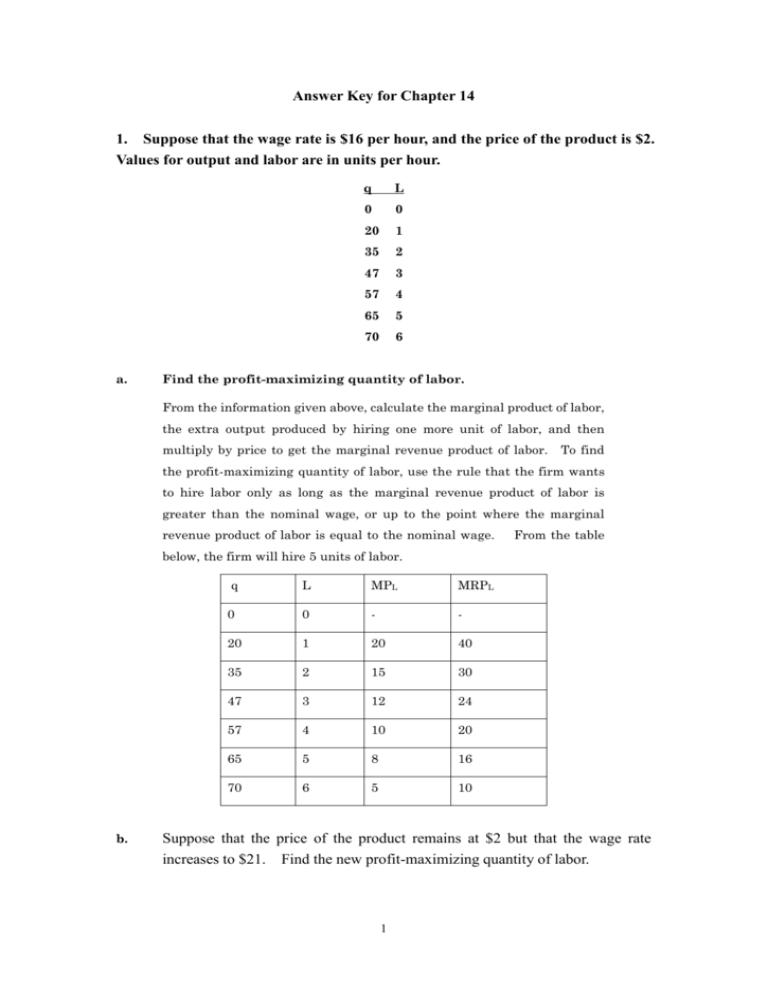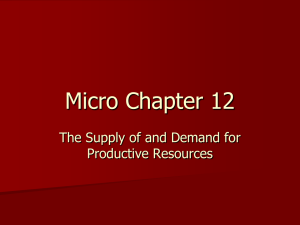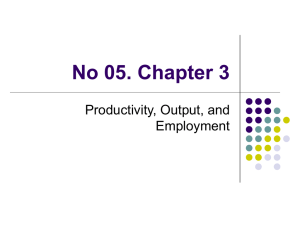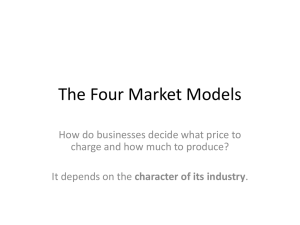Questions review:
advertisement

Answer Key for Chapter 14 1. Suppose that the wage rate is $16 per hour, and the price of the product is $2. Values for output and labor are in units per hour. a. q L 0 0 20 1 35 2 47 3 57 4 65 5 70 6 Find the profit-maximizing quantity of labor. From the information given above, calculate the marginal product of labor, the extra output produced by hiring one more unit of labor, and then multiply by price to get the marginal revenue product of labor. To find the profit-maximizing quantity of labor, use the rule that the firm wants to hire labor only as long as the marginal revenue product of labor is greater than the nominal wage, or up to the point where the marginal revenue product of labor is equal to the nominal wage. From the table below, the firm will hire 5 units of labor. b. q L MPL MRPL 0 0 - - 20 1 20 40 35 2 15 30 47 3 12 24 57 4 10 20 65 5 8 16 70 6 5 10 Suppose that the price of the product remains at $2 but that the wage rate increases to $21. Find the new profit-maximizing quantity of labor. 1 The above table does not change for this part of the problem. However, the firm no longer wants to hire 5 units of labor because the benefit of the 5th unit ($16 per hour) is less than the cost of the 5 th unit ($21 per hour). The firm would only hire 3 units of labor per hour since in this case the benefit still exceeds the cost at the margin. The firm would stick with 3 units instead of 4 unless fractional units are possible. At L=4 the cost is greater than the benefit so you lose profit by hiring the 4th unit of labor. c. Suppose the price of the product increases to $3 and the wage remains at $16 per hour. Find the new profit-maximizing quantity of labor. A change in the price of the product will not change the marginal product of labor, but it will change the marginal revenue product of labor. The new marginal revenue product of labor is given in the table below. The firm will still want to hire 5 units of labor, as in part a above. It will not hire the 6th unit because the extra benefit is less than the extra cost. Profit will be greater than in part a. d. q L MPL MRPL 0 0 - - 20 1 20 60 35 2 15 45 47 3 12 36 57 4 10 30 65 5 8 24 70 6 5 15 Suppose that the price of the product remains at $2 and the wage remains at $16, but there is a technological breakthrough that increases output by 25% for any given level of labor. Find the new profit-maximizing quantity of labor. The technological breakthrough changes the number of units of output produced by a given number of units of labor, and hence changes the marginal product and the marginal revenue product of labor. The new output values are found by multiplying the old values by 1.25. This new information is given in the table below. units of labor. The firm will still choose to hire 5 Profit will be greater than in part a. 2 q L MPL MRPL 0 0 - - 25 1 25 50 43.75 2 18.75 37.5 58.75 3 15 30 71.25 4 12.5 25 81.25 5 10 20 87.5 6 6.25 12.5 3. Using your knowledge of marginal revenue product, explain the following: a. A famous tennis star is paid $100,000 for appearing in a 30-second television commercial. The actor who plays his doubles partner is paid $500. Marginal revenue product of labor, MRPL, is equal to marginal revenue from an incremental unit of output multiplied by the marginal product from an incremental unit of labor, or in other words, the extra revenue generated by having the tennis star appear in the ad. The famous tennis star is able to help increase revenues far more than the actor, so he is paid much more than the actor. The wage of the actor is determined by the supply and demand of actors willing to play tennis with tennis stars. b. The president of an ailing savings and loan is paid not to stay in his job for the last two years of his contract. The marginal revenue product of the president of the ailing savings and loan is likely to be negative and therefore, the savings and loan is better off by paying the president not to show up. They have calculated that they will lose less (or gain more) by paying the president off and hiring someone else. c. A jumbo jet carrying 400 passengers is priced higher than a 250-passenger model even though both aircraft cost the same to manufacture. The ability of the larger jet to generate more revenue increases its value to the airline, and therefore the airline is willing to pay more for it. 3 8. The demand for labor by an industry is given by the curve L = 1200 - 10w, where L is the labor demanded per day and w is the wage rate. The supply curve is given by L = 20w. What is the equilibrium wage rate and quantity of labor hired? What is the economic rent earned by workers? The equilibrium wage rate is determined where quantity of labor supplied is equal to the quantity of labor demanded: 20w = 1,200 - 10w, or w = $40. Substituting into either the labor supply or labor demand equations, we find the equilibrium quantity of labor is 800: LS = (20)(40) = 800, and LD = 1,200 - (10)(40) = 800. Economic rent is the summation of the difference between the equilibrium wage and the wage given by the labor supply curve. Here, it is the area above the labor supply curve up to L = 800 and below the equilibrium wage. This triangle’s area is (0.5)(800)($40) = $16,000. 9. This exercise is a continuation of Exercise 8. Suppose now that the only labor available is controlled by a monopolistic labor union that wishes to maximize the rent earned by union members. What will be the quantity of labor employed and the wage rate? How does your answer compare with your answer to Exercise 8? Discuss. (Hint: The union’s marginal revenue curve is given by L = 1200 - 20w.) Recall that the monopolist chooses output by setting marginal revenue equal to the marginal cost of supplying one more unit of output, as opposed to the competitive firm which chooses output by setting price equal to marginal cost, or in other words producing where supply intersects demand. The monopolistic labor union acts in the same way. To maximize rent in this case, the union will choose the number of workers hired so that the marginal revenue to the union (the additional wages earned) is equal to the extra cost of inducing the worker to work. This involves choosing the quantity of labor at the point where the marginal revenue curve crosses the supply curve of labor. Note that the marginal revenue curve has twice the 4 slope of the labor demand curve. Marginal revenue is less than the wage, because when more workers are hired, all workers receive a lower wage. Setting the marginal revenue curve equal to the supply curve for labor, we find: 1200 - 20w = 20w, or w* = 30. At w*, we may determine the number of workers who are willing to work by substituting w* into the labor supply equation: L* = (20)(30) = 600. Therefore, if the union wants to maximize the rent that the union members earn, the union should limit employment to 600 members. To determine the wage the members will earn, substitute L* into the labor demand equation: 600 = 1,200 - 10w, or w = 60. The total rent the employed union members will receive is equal to: Rent = (60 - 30)(600) + (0.5)(30)(600) = $27,000. Notice that the wage is higher and the number of workers employed is lower than in Exercise (8). 5








